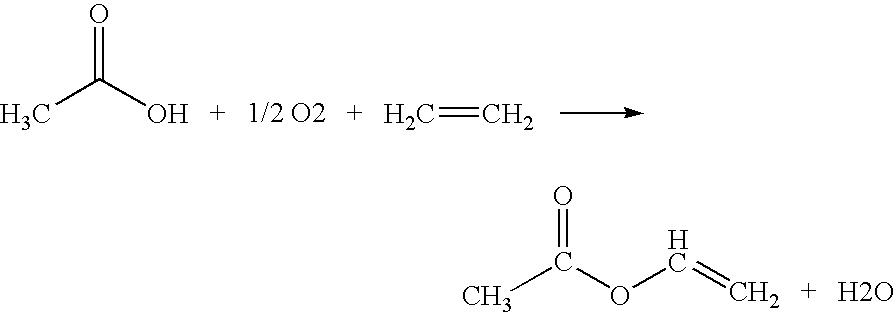Integrated process for the production of viny acetate from acetic acid via ethy acetate
a technology of acetic acid and ethyl acetate, which is applied in the direction of physical/chemical process catalysts, metal/metal-oxide/metal-hydroxide catalysts, energy input, etc., can solve the problems of significant amounts of by-products, extreme reaction conditions are unacceptable and uneconomical for a commercial operation, and industrial unsuitability, etc., to achieve high selectivity and yield
- Summary
- Abstract
- Description
- Claims
- Application Information
AI Technical Summary
Benefits of technology
Problems solved by technology
Method used
Image
Examples
example a
Preparation of 1 Weight Percent Platinum and 5 Weight Percent Copper on High Purity Low Surface Area Silica
[0114]Powdered and meshed high purity low surface area silica (94 g) of uniform particle size distribution of about 0.2 mm is dried at 120° C. in an oven under nitrogen atmosphere overnight and then cooled to room temperature. To this is added a solution of platinum nitrate (Chempur) (1.64 g) in distilled water (16 ml). The resulting slurry is dried in an oven gradually heated to 110° C. (>2 hours, 10° C. / min). The impregnated catalyst mixture is then calcined at 500° C. (6 hours, 1° C. / min). To this calcined and cooled material is added a solution of copper nitrate trihydrate (Alfa Aesar) (19 g) in distilled water (19 ml). The resulting slurry is dried in an oven gradually heated to 110° C. (>2 hours, 10° C. / min). The impregnated catalyst mixture is then calcined at 500° C. (6 hours, 1° C. / min).
example b
Preparation of 1 Weight Percent Palladium and 5 Weight Percent Cobalt on High Purity Low Surface Area Silica
[0115]Powdered and meshed high purity low surface area silica (94 g) of uniform particle size distribution of about 0.2 mm is dried at 120° C. in an oven under nitrogen atmosphere overnight and then cooled to room temperature. To this is added a solution of palladium nitrate (Heraeus) (2.17 g) in distilled water (22 ml). The resulting slurry is dried in an oven gradually heated to 110° C. (>2 hours, 10° C. / min). The impregnated catalyst mixture is then calcined at 500° C. (6 hours, 1° C. / min). To this calcined and cooled material is added a solution of cobalt nitrate hexahydrate (24.7 g) in distilled water (25 ml). The resulting slurry is then dried in an oven gradually heated to 110° C. (>2 hours, 10° C. / min). The impregnated catalyst mixture is then calcined at 500° C. (6 hours, 1° C. / min).
example c
Preparation of 1 Weight Percent Palladium and 5 Weight Percent Cobalt on H-ZSM-5
[0116]The procedures of Example B are substantially repeated except for utilizing H-ZSM-5 as the catalyst support.
PUM
| Property | Measurement | Unit |
|---|---|---|
| weight ratio | aaaaa | aaaaa |
| pressure | aaaaa | aaaaa |
| temperature | aaaaa | aaaaa |
Abstract
Description
Claims
Application Information
 Login to View More
Login to View More - R&D
- Intellectual Property
- Life Sciences
- Materials
- Tech Scout
- Unparalleled Data Quality
- Higher Quality Content
- 60% Fewer Hallucinations
Browse by: Latest US Patents, China's latest patents, Technical Efficacy Thesaurus, Application Domain, Technology Topic, Popular Technical Reports.
© 2025 PatSnap. All rights reserved.Legal|Privacy policy|Modern Slavery Act Transparency Statement|Sitemap|About US| Contact US: help@patsnap.com



